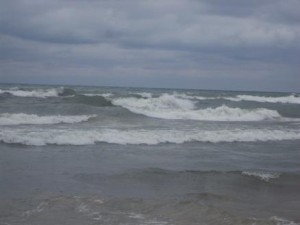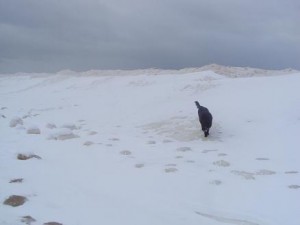Recently I met with a friend who I hadn’t seen since before Nate’s cancer. After we shared a hello and a hug, she said, “Well, I sure can see this whole thing has taken a big toll on you.”
I think she meant I looked worn and haggard. That’s certainly how I felt. Ongoing grief is exhausting. Just when you think the worst is over, a new wave of sadness washes over you like an icy dousing without warning. It’s similar to watching a sand castle get swamped when a wave rolls past its natural boundary and overwhelms it.
The interesting thing about waves of grief is that they’re much like waves of water. They rush in, but they also rush out again, usually fairly quickly. I think of the fun of a wavy day at the beach when we were kids and how we bobbed on the surface, using the waves to our advantage, until a big one crashed overhead. Then it was tumble and toss, often with water going up our noses, until we could get our footing again and come up for air.
Waves of grief are much like that. We’re moving through a day successfully when unexpectedly a wave knocks us down and floods us with tears. That happened to me today as I sat at the dining room table writing a few notes. I was answering a letter in which a friend had written, “We want to continue getting together with you,” and all of a sudden I was crying. A picture of the four of us came to mind, engaged in lively conversation, except that it was only three of us, a sad scene I couldn’t bear.
My crying lasted about three minutes. I had to get up to find some Kleenex but shortly after that was back finishing the note. A wave had broken over me but had quickly receded, just like at the beach.
God separated the dry land from the sea at creation, defining the boundaries of the waves, and he separates waves of grief from those who mourn, defining those boundaries as well. In both cases, he lets the waves come, but it’s “this far and no farther” as he controls their power.
An interesting thing has happened to the waves of Lake Michigan this week. With the colder temperatures, water that has splashed up on the snow-covered beach has frozen into lumps of sandy ice. Each wave has added another layer to the lump until mounds of ice have grown too high to see over. Climbing up the slick hills is nearly impossible with regular snow boots. Jack has an advantage with his claws, but even he slips and slides backwards now and then.
The mounds of ice continue to grow in height. Wild waves hit the icy ridge with a crash so powerful it causes water to splash ten feet into the air, landing atop the hill and rapidly freezing, thus adding new height. Unlike summertime waves that roll up and quickly fall back, these waves rise and freeze, one atop another.
Grief is like that, too. If we hold back the tears and don’t allow ourselves to experience the sadness, grief freezes inside of us, building layer upon layer until it becomes a mountain beyond which we can’t see. It’s much better to let it surge up, come out in tears and then recede.
When I break down and have to stop what I’m doing to be sad for a few minutes, I ought to also be glad, knowing God’s healing is in process. He’s keeping a watchful eye on those waves, and when they wash up too far or come too close together, he moves in to force them back. If I let them come flowing out in tears, they’ll never be able to freeze up (and mound up) deep inside.
“You [Lord] rule over the surging sea; when its waves mount up, you still them.” (Psalm 89:9)
“I [declares the Lord] made the sand a boundary for the sea, an everlasting barrier it cannot cross. The waves may roll, but they cannot prevail; they may roar, but they cannot cross it.” (Jeremiah 5:22)





